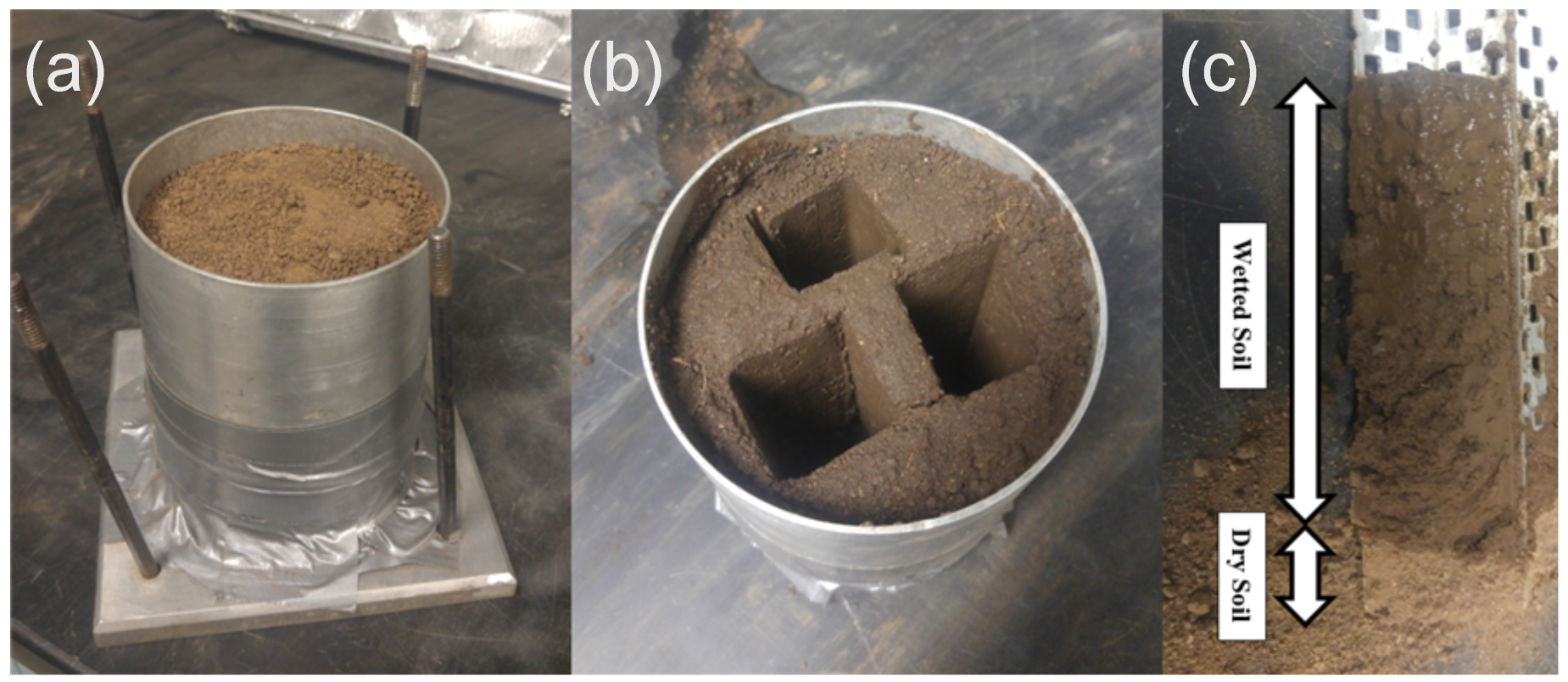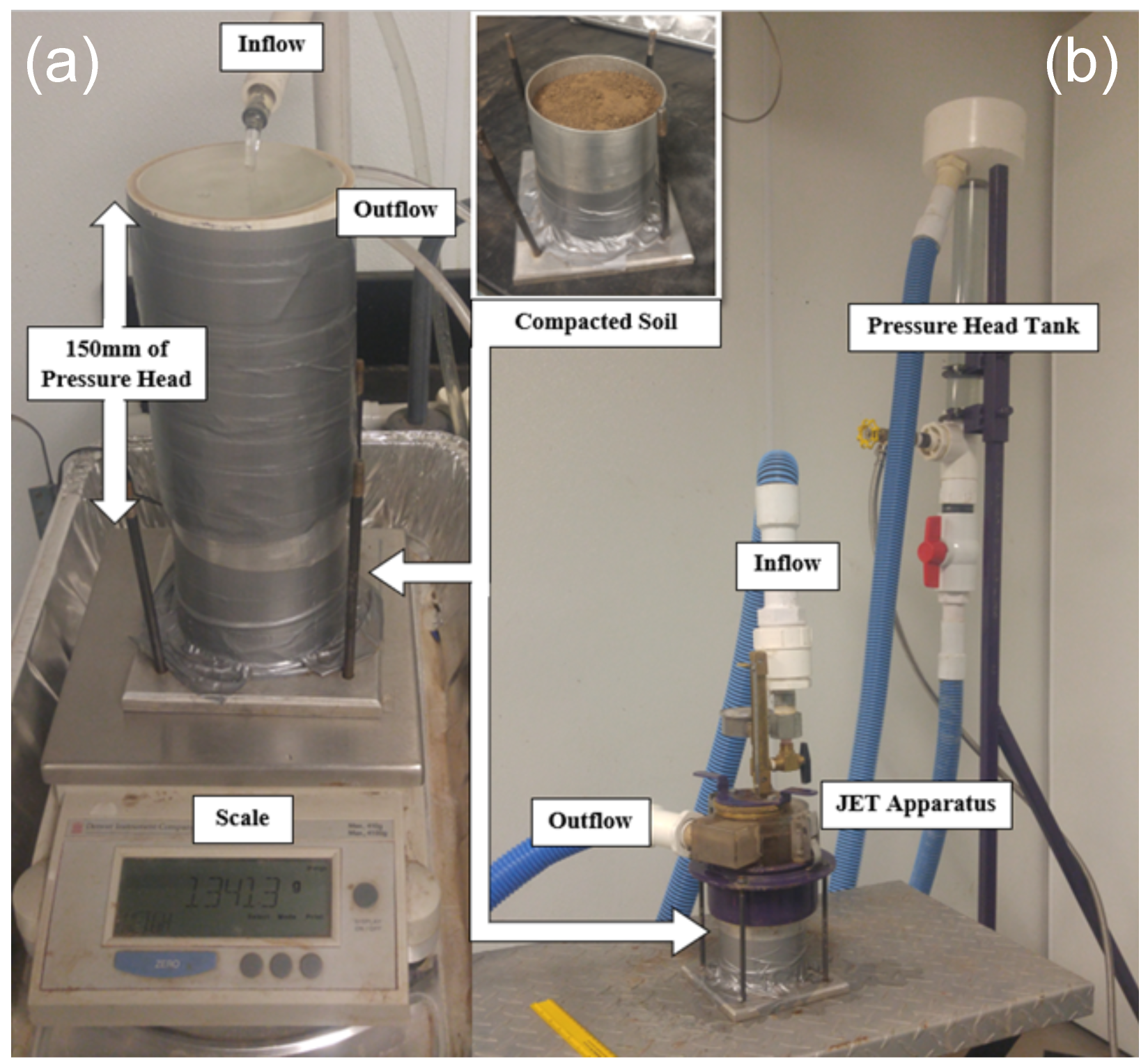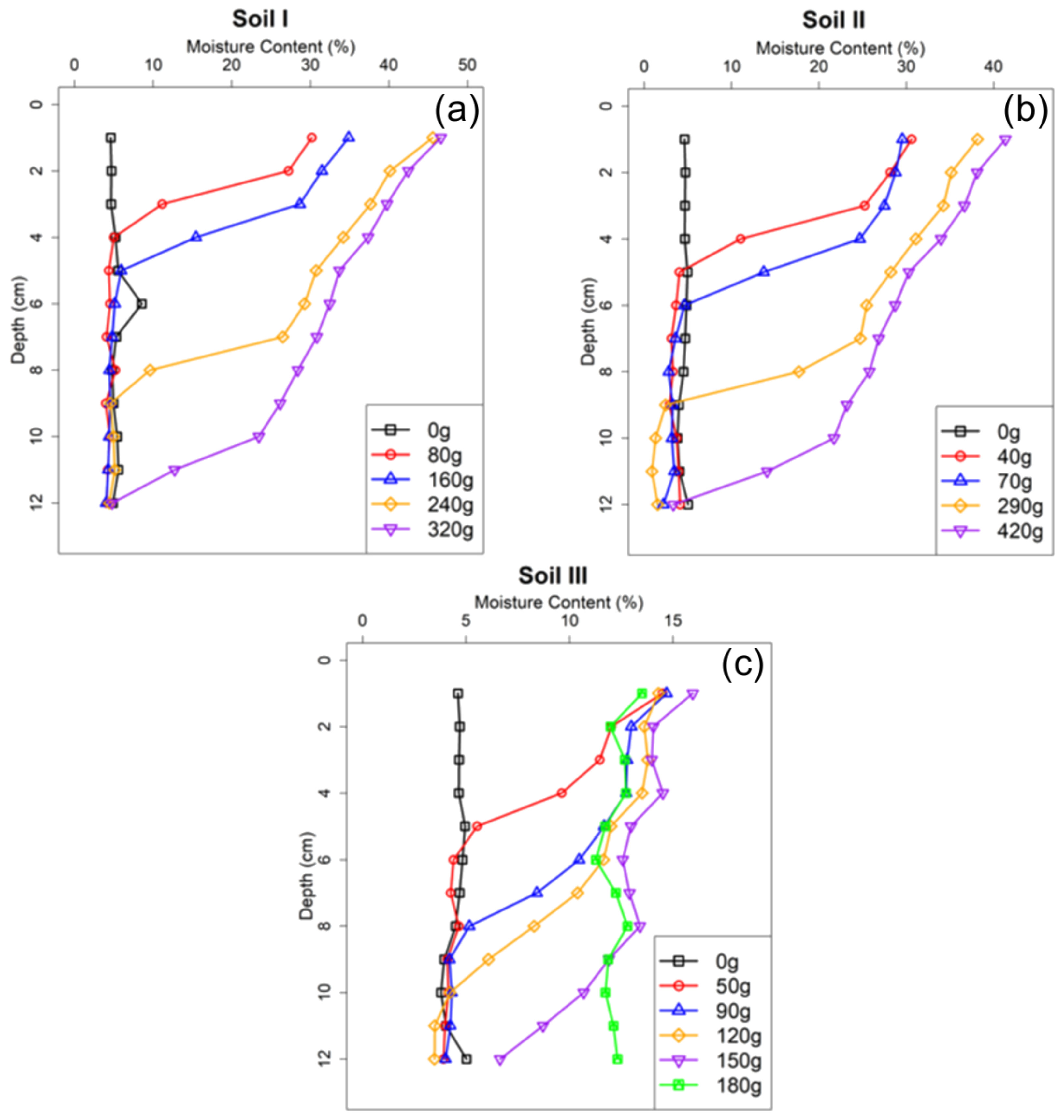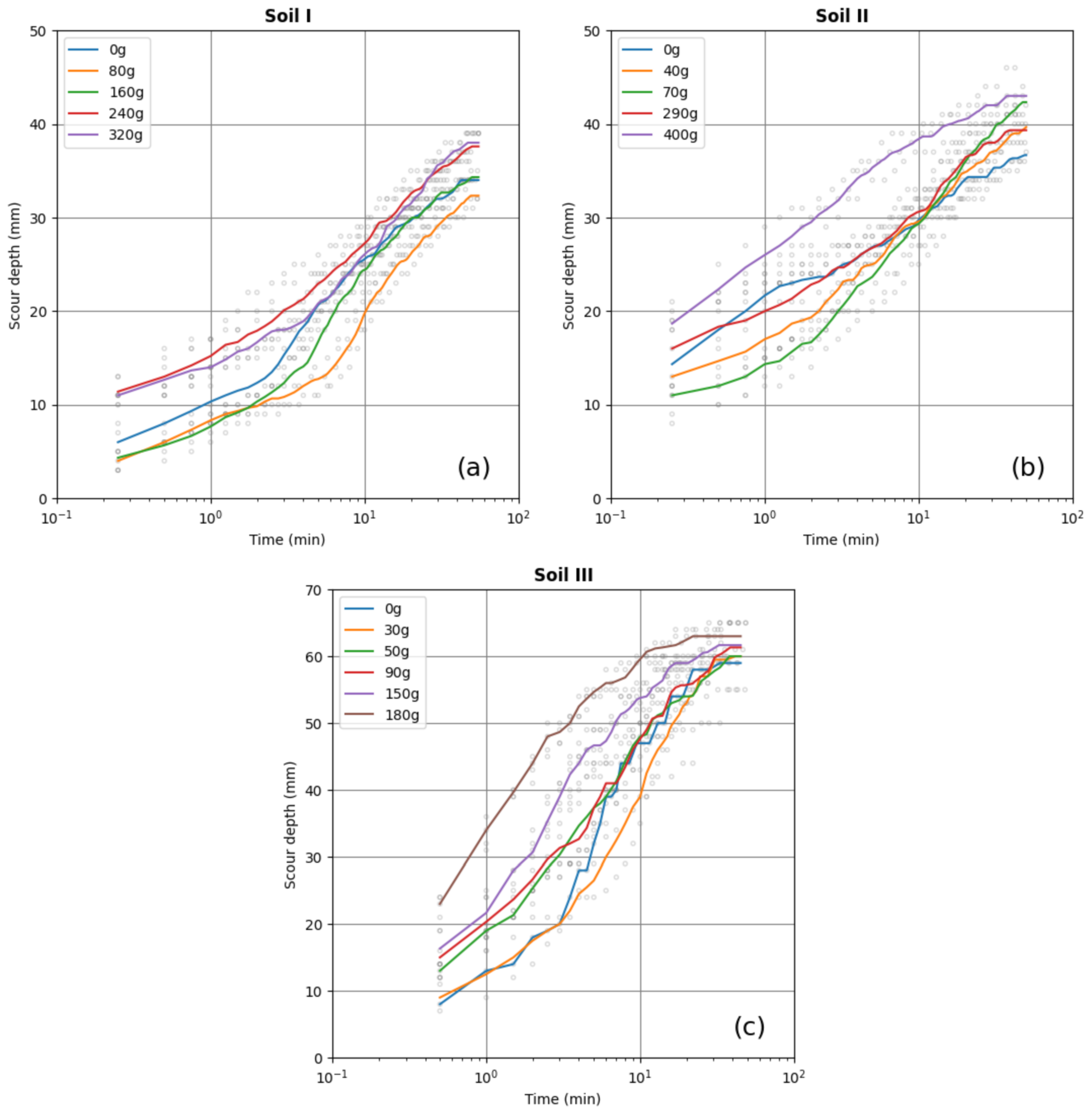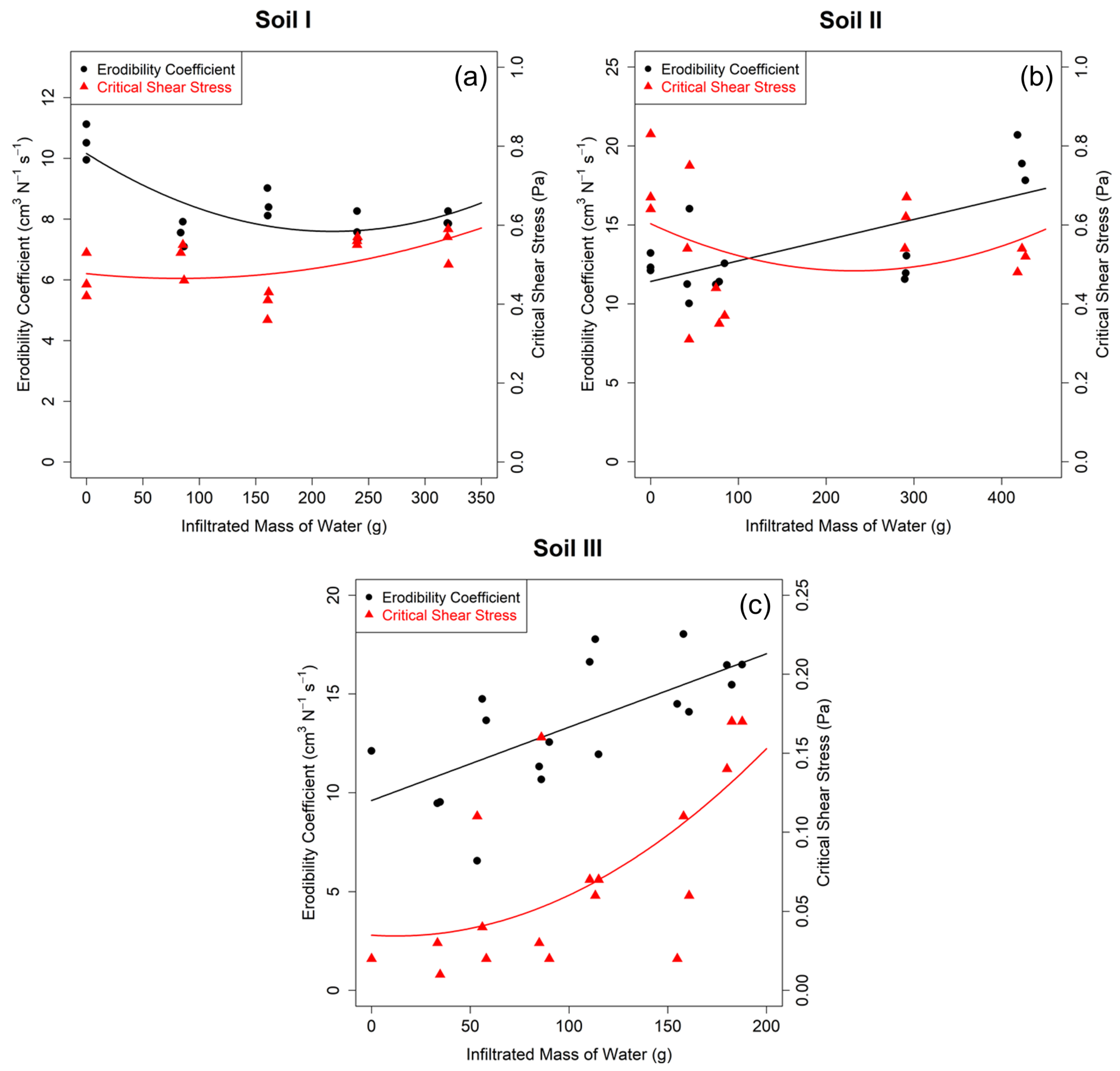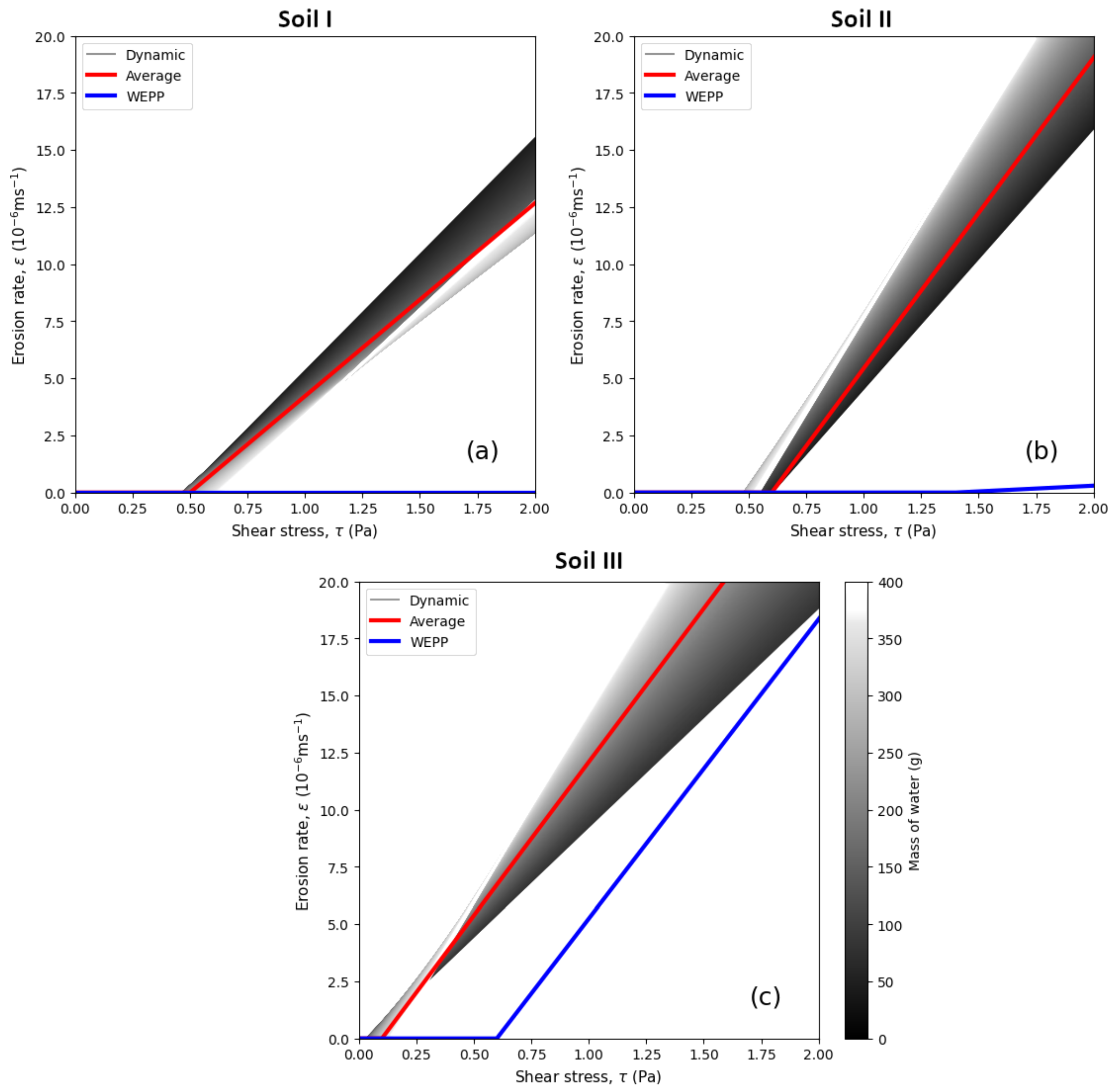1. Introduction
Soil erosion by water accounts for more than half of all soil erosion on U.S. cropland with an estimated 980 million Mg of topsoil lost in 2017 to sheet and rill erosion alone (
https://www.nrcs.usda.gov/nri, accessed on 1 February 2024; [
1]). Soil erosion leads to numerous environmental problems including reservoir and stream sedimentation, loss of agricultural land, and declines in drinking water quality [
2,
3]. It is imperative to accurately predict soil erosion caused by runoff processes so that mitigation efforts can be undertaken proactively before large-scale sedimentation and water quality problems arise.
Soil detachment by water is often described by the excess shear stress Equation (
1):
where
is the rate of soil loss (ms
−1),
is the applied hydraulic stress (Pa),
is the erodibility coefficient (
N
−1s
−1),
is the critical shear stress (Pa), and
a (
) is an empirical exponent very often assumed to be unity [
4,
5]. Soil erosion is zero if hydraulic stresses are smaller than the critical shear stress (
if
).
Some experimental techniques for quantifying soil erodibility parameters in Equation (
1) include open channel erosion tests conducted in a flume [
6], monitoring soil erosion in field plots [
7], and repeated measurements of erosion pins [
8]. The implementation of these methods is expensive in terms of cost, labor, and time; thus, alternative experimental methods can be considered. One such alternative laboratory technique for estimating soil erodibility parameters utilizes a circular jet testing technique pioneered by Hanson and Cook [
9] and further developed into a jet erosion test apparatus [
6,
10]. The Jet Erosion Test (JET) is a laboratory experiment that uses an apparatus to apply an impinging jet of water into a soil sample and create a scour. Based on the recorded scour depth over time during the test and using the characteristics of the experimental setup (such as nozzle velocity, pressure head, and discharge coefficient), an analytical approximation of the shear stress relationship applied at the soil sample’s surface can be derived. This approximation takes the form of a non-linear scour depth equation that can be solved for best fit values of
and
using mathematical optimization approaches [
9,
11]. A popular approach is the solution based on work by Blaisdell et al. [
12], which applies a hyperbolic function to better fit the observed scour depth over time by adjusting values of the coefficients
and
.
The accuracy of the derived soil erodibility parameters was evaluated by Hanson and Cook [
6] who concluded that the JET method was a comparable method to established methods (open channel flumes). However, the results of JET experiments can have a high degree of variability in estimating
and
. The variability can be attributed to many factors including a variability of soil samples, soil sample preparation techniques, operation of the JET experiment, size of sample mold, and parameter estimation solution approaches. A study by Liu et al. [
13] evaluated soil erodibility parameters for three soils (sandy loam with 69% sand, silt loam with 72% silt, and silty clay with 39% clay) and five initial soil water conditions. The results for the studied soils showed that both parameters were affected by soil texture, pore void ratio, and soil water potential. Khanal et al. [
14] conducted numerous JET experiments on two streambank soils and evaluated the impacts of user-controlled experiment parameters, such as, hydraulic pressure head, initial interval of scour depth measurement, and termination time. It was found that combinations of the factors were more important for variability of experiment outcomes than the impact of the sole factors, and the impact increased at larger head settings.
Soil erodibility parameters
and
in Equation (
1) are normally assumed constant and dependent only on soil pedology factors. As an example, in a widely used soil erosion model WEPP (The Water Erosion Prediction Project [
15,
16]), the main dependent factors include texture, organic matter, and particle size distribution. Lisenbee et al. [
17] compared the results of JET experiments for soils of tallgrass prairie and red ceder woodlands with the estimates from the WEPP model under varying soil conditions and found out that the WEPP-based
were smaller that JET-derived values, while the values of
were within the same order of magnitude. In addition, laboratory and field studies have shown that these parameters may vary with the changes in soil moisture content and pore pressure gradients that occur during rainfall, surface runoff, and/or soil infiltration events [
3,
13,
18,
19,
20,
21,
22,
23].
The JET apparatus was used in several studies to assess the impact of soil water states on soil erodibility [
13,
20,
23,
24]. For example, Hanson and Hunt [
24] investigated the effects of compaction and soil moisture in loam and sandy loam soils using a laboratory JET device and concluded a curvelinear relationship between the erodibility coefficient and a sample water content with its minimum value representing lowest rate of soil erosion. Recent work by Khanal et al. [
23] investigated the impact of soil moisture on the derived soil erodibility parameters of clay loam and sandy loam soils utilizing the mini-JET apparatus and varying soil moisture contents of the samples using an apparatus that simulated the infiltration process. It was concluded that as soil moisture increased,
and
also increased. In addition to initial water content, the effect of seepage forces on soil erodibility was evaluated in [
20] and yielded that the observed scour depth increased, the critical shear stress decreased, and the erodibility coefficient increased when a soil was exposed to increasing seepage forces during the experiment.
The effects of soil moisture and dynamic pore pressure gradients on soil erodibility parameters were apparent in other methods of estimating soil erodibility parameters as well. A study investigating the effect of seepage on soil erodibility using a V-shaped flume discovered that a soil exhibited higher erodibility when it was under seepage conditions as opposed to drainage conditions [
19]. Additionally, a laboratory study of clay-type soils in Texas using a rotating-cylinder test apparatus found a negative linear relationship between the critical shear stress,
, and soil moisture content [
25]. That study observed a decrease of 50% in
for a 15% increase in soil moisture content. A field study in central Kansas on ephemeral gully evolution in a silty clay soil found out that intrastorm dynamics of subsurface soil moisture play an important role in channel development and erosion rate estimates [
21,
22]. It was concluded that runoff events with lower antecedent soil moisture condition caused smaller soil erosion rates compared to the events with fully saturated soil.
The evidence from the previous studies showed the varying impact of soil water on shear strength and cohesiveness of soils. The positive effect refers to increased cohesiveness, improved soil resistance to scour and reduced erosion rates as evidenced, for example, by Huang and Laften [
26] and Khanal et al. [
23]. The negative effect relates to weakening of interparticle binding forces, enhanced particle detachment due to applied shear, and increased erosion rates [
27]. The dynamic effects of time-dependent soil moisture content and its variability with depth during rainfall events, affected pore pressure gradients, and seepage and subsurface flows are not well understood and require additional attention from experimental and modeling studies. Thus, it becomes vital to understand how these effects can be quantified over a wide range of soil texture classes and under different soil water profiles. Therefore, the objective of this study was to evaluate the dynamic effects of infiltration on the erodibility coefficient and critical shear stress for representative soils on agricultural fields using the JET technique. We focused on soils with different soil texture and organic matter content collected from rangeland and cultivated cropland fields under conventional tillage and no-till practices.
3. Results
3.1. Soil Moisture Distribution
The infiltration experiment was repeated three times for each mass of infiltrated water for each soil. Five amounts of water (in grams) were infiltrated in soil I (0, 80, 160, 240, 320 g) and soil II (0, 40, 70, 290, 420 g) while six different masses were selected for soil III (0, 50, 90, 120, 150, 180 g). For each experiment, a soil moisture content distribution with depth was developed, and average values of three samples at each depth were calculated (
Figure 3). The curves followed a typical infiltration profile with saturation decreasing from the highest value at the top to near initial saturation at the bottom with the wetting front caused by the infiltrated mass of water clearly identifiable. At later times of infiltration, gravity was the primary controlling force and caused water to accumulate at lower depths because of a no flow boundary condition at the bottom. Saturation at the top of the sample was determined at a depth of 1 cm; however, it can be inferred that the top boundary was at full saturation due to the presence of ponded water in the JET apparatus during the tests.
Soil I had the slowest infiltration rate by infiltrating higher amounts of water within the same time periods. This is due to its lower hydraulic conductivity and higher organic matter content compared to the other soils. Soil III had the highest sand fraction of all three soils at 74% and the highest hydraulic conductivity, which manifested in a faster percolation of water through the soil profile compared to soils I and II. Overall, before water ponded on the bottom, and the sample became fully saturated, soil II infiltrated the highest amount of water at 420 g, while soil III had the least amount of water at 150 g.
3.2. Scour Depth with Time
Similar to the infiltration experiment, five different masses (in grams) of infiltrated water were selected for soil I (0, 80, 160, 240, 320) and soil II (0, 40, 70, 290, 420), and seven different masses for soil III (0, 30, 50, 90, 120, 150, 180). The JET experiment was repeated three times for each mass of infiltrated water for each soil, with exceptions for soil III (0 g, one experiment; 30 g, two experiments). A total of 45 JET experiments were conducted with the samples of different infiltrated masses of water.
In each JET experiment, scour depth was recorded at 15 s to 5 minute intervals [
28,
29]. At the initial stage of the experiment, observed scour increased rapidly, which required smallest intervals between measurements (i.e., 15 s). Once the mold became more saturated, the recording interval was gradually increased to 5 min. The experiment ended when no changes were recorded for at least two consecutive 5 min intervals and the equilibrium depth was assumed reached.
Scour depth measurements are presented in a log time scale in
Figure 4 as gray open circles for all experiments, while the average depths were shown as solid lines for molds with different masses of infiltrated water. The scour rates were the highest at the beginning and reduced to zero at the end of the experiment. The average time to reach the equilibrium depth varied from 34 to 55 min, with soil II having the fastest rates. The final scour depths varied from 32 mm for 80 g in soil I to 65 mm for 180 g in soil III. On average, for all infiltrated mass of water, soil I produced the smallest scours and soil III showed the highest scour depths.
In each experiment, samples with smaller amounts of infiltrated water produced smaller scours at the beginning of the experiment and then mostly maintained the difference with time than the samples with higher amounts of infiltrated water (i.e., see orange curve vs purple curve). Initially dry samples (0 g infiltrated mass, blue curves) had higher scours than the slightly wet samples (80 g, 160 g for soil I; 40 g, 70 g for soil II; 30 g for soil III) but lower scours than the fully wet samples (240 g, 320 g for soil I; 290 g, 400 g for soil II; 150 g, 180 g for soil III).
3.3. Soil Erodibility Parameters
For each JET experiment, soil erodibility parameters
and
were derived with the Blaisdell solution using scour depth time series from
Figure 4. Summary results of the soil erodibility parameters derived from 45 JET experiments are presented in
Figure 5 for soils I, II, and III (
Table 1). For each
and
, a parabolic form regression fit Equation (
8) was derived as a function of the mass of water:
where
P is the erodibility parameter (
or
),
M is the mass of infiltrated water (g), and
b,
c, and
d are constant regression coefficients. The calibrated values for
b,
c, and
d and the coefficient of determination
are shown separately for
and
in
Table 2 for each soil. The average
and
from all JET experiments are also shown in the table for each soil.
All soils showed significant changes in the derived erodibility coefficients over the range of tested masses of infiltrated water. Soil I displayed a curvelinear relationship for
, suggesting that there was an optimum time (210 g) during the infiltration process when it reached a minimum value. This observation follows similar trends in studies by Hanson and Hunt [
24] and Hanson and Robinson [
33], which concluded that there may be an optimum soil moisture content at which the erodibility coefficient is at a minimum. In contrast, soils II and III displayed almost a linear increase in
with increasing infiltration which suggested that the soil detachment process would occur at a higher rate at later times during the infiltration process, assuming the applied hydraulic shear stress was higher than the critical shear stress during the process. Khanal et al. [
23] observed similar increases in
with increasing soil moisture content; however, they concluded that the trend observed for their sandy loam soil was statistically insignificant.
Critical shear stress displayed variability with increase of infiltrated mass of water. For soils I and II,
displayed higher values for initially dry samples than for slightly infiltrated soils, with consecutive increases in
with more water infiltrated into the sample (
Figure 5a,b). Soil III displayed a positive curvelinear relationship with the values increasing an order of magnitude from 0.012 Pa for
M < 100 g to 0.16 Pa for
M close to 180 g (
Figure 5c). These results suggest that when water infiltrates into the soil profile, clay loam soils I and II are likely more susceptible to erosion than sandy loam soil III during smaller runoff or other events where the applied hydraulic shear stress is low, while sandy loam soil III can be more resistant to erosion as the infiltration process progresses and soil becomes saturated.
4. Discussion
The results from the mini-JETs showed the variability in estimated erodibility coefficients with the values reflecting the change in initial soil moisture condition and amounts of infiltrated water
M. The critical shear stress exhibited a decrease with the increase of
M, while the erodibility coefficient generally showed an increase for soils II and III with slightly higher values at
g for soil I (
Figure 5). The variability in parameters was indicative of the variability in scour depth curves in
Figure 4. The increase of
M generally produced deeper scours immediately from the beginning of each JET test. Higher initial scours for relatively dry soils I and II resulted in higher
values for lower
M. The scour growth rate was significantly higher for sandy loam soil III than for (silty) clay loam soils I and II at any
M due to higher sand content and higher soil bulk density (see
Table 1).
For comparison with the experiments, the WEPP-based baseline constants
and
are presented for the three studied soils in
Table 2. Based on the baseline conditions alone, the JET-averaged values
and
were different from the WEPP-based baseline
and
values for soils I and II, while soil erodibility coefficient values were close for soil III.
To quantify the effect of the dynamic nature of soil erodibility parameters observed in the JET experiments on the prediction of soil erosion, the erosion rates
in Equation (
1) were calculated for each soil using three approaches for the estimation of the erodibility parameters (
Table 2). The values of
and
were evaluated as follows:
- (i)
Dynamic and as a function of mass of infiltrated water M with coefficients b, c, and d;
- (ii)
Average values and , and;
- (iii)
Baseline coefficients and from the WEPP model.
In approach (i), the erosion rate
changes based on the values of
and
adjusted for the amount of infiltrated water
M, while approaches (ii) and (iii) utilize constant coefficients. The erosion rate is calculated as a function of hydraulic shear stress
and presented in
Figure 6 for different approaches. The erosion rate is zero for
and linearly increases afterwards. The dynamic erosion rates for approach (i) are presented as a grayed area to visualize how the range of infiltrated mass of water
M varied from 0 g (light gray) to up to 400 g (dark gray). The range of the erosion rate widens with the increase of
. Since
are greater than the dynamic and average
, the erosion rate for JET-derived coefficients starts at lower values of
(gray and red curves) and exceeds WEPP estimated values of
. For higher
Pa for soil III, the dynamic range of
can encapsulate the estimates from both (ii) average and (iii) WEPP approaches.
During a surface runoff event, rate of overland flow and hydraulic shear stresses applied at soil surface can vary with time and event intensity, thus causing variable soil detachment and subsequently soil erosion rates [
22]. At the same time, surface water infiltrated into soil can affect soil cohesiveness and cause pore pressure to rise. The effect can differ for soils of different texture, plasticity, and cohesiveness. The magnitude of that effect and its impact on soil detachment and soil erosion are not well understood.
In regards to the formulation in Equation (
1), the infiltrated water during the rainfall event makes soil moisture content time-dependent, which dynamically affects both erodibility parameters
and
according to
Figure 5. In response, the corresponding effect on soil erosion rates can vary, with a higher range of variability for higher runoff depths (see
Figure 6). This experimental study presents an attempt to quantify the combined effect of water infiltration and applied shear stresses on soil erodibility. Although the erodibility coefficients
and
were found to be dependent on the infiltrated mass of water, the impact is distinctive but relatively mild, especially at the lower
, and needs additional assessment with JET or other laboratory and field experiments.
5. Conclusions
The effects of infiltration and soil water content on soil erodibility parameters were analyzed for three soils (clay loam, silty clay loam, and sandy loam) using the laboratory Jet Erosion Test. Soil samples were prepared and subjected to infiltration with different masses of infiltrated water prior to each JET. Scour depths were recorded for 45 JET experiments and analyzed with the Blaisdell solution for the erodibility parameters and . Results from these experiments not only showed variability in the erodibility parameters across different soil types but also depicted a dynamic relationship between the soil erodibility parameters and mass of infiltrated water.
To determine the impact of the dynamic nature of the derived soil erodibility parameters on soil erosion, the erosion rates were calculated with an excess shear stress equation for three studied soils over a broad range of applied hydraulic shear stresses using three different approaches. The approaches included determining the parameters as a function of infiltrated mass of water, using average values from this study, or applying specific formulas from the Water Erosion Prediction Project (WEPP) model. The WEPP approach produced lower erosion rates compared to both the dynamic and average approaches, mainly due to higher values of the estimated critical shear stress. We note that WEPP-based erodibility approach represents baseline soil condition and does not account for soil specific features, such as, residue, plant roots and biomass, and soil crusting and sealing. The impact of dynamic erodibility parameters is seen at any applied shear stress but the estimated erosion rates have a wider range of values for higher .
The results of this study highlight the importance of evaluating the effects that soil moisture or water infiltration rates during surface runoff events have on soil erosion. Specifically, a concave form of the critical shear stress curve may impact the threshold for the acting shear stress to initiate soil particle detachment at low antecedent soil moisture condition. The increase in erodibility coefficient with soil moisture content can enhance soil erosion rates once the soil becomes more saturated during the rainfall event. As the direct impact of infiltrated mass of water or soil moisture on the erodibility parameters is difficult to evaluate in situ, the use of proxy factors can be considered, such as antecedent soil moisture content, time to peak from the start of runoff, soil cohesion, etc. Further assessment of such factors with JET or other laboratory and field tests is recommended.
